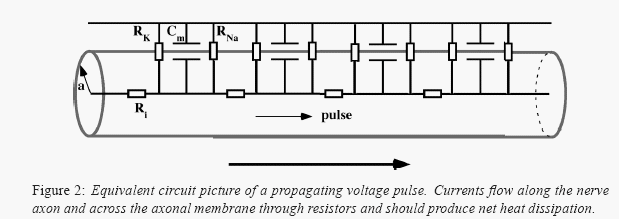Danska fysiker: Nervimpulser är ljudpulser, inte elektricitet
Här ett riktigt revolutionerande förslag som kommer från fysiker verksamma i Danmark, som tittat på nervsystemet. Deras utgångspunkt är enkel: Om nervimpulser är elektriska, varför ser vi inte en värmeutveckling?
Som alternativ har de utvecklat en hypotes där man ser nerver som mycket effektiva bärare av ljudpulser. Man menar sig då också kunna förklara bedövningsmedel, vilket man inte klarat tidigare: De ändrar densiteten i nervdelar så att ljudpulserna släcks ut. Om denna hypotes är sann så är det verkligen revolutionerande.
Läs mer: Physicists challenge notion of electric nerve impulses; say sound more likely | Science Blog
Uppdatering 20:11
Hypotesen har funnits i decennier enligt denna kommentar på Science Blog.
Uppdatering 8 mars 2007:
Här ett paper (pdf) där forskarna utvecklar sina teorier.
I detta paper menar man bl a att:
Man kan i aktta storleksförändringar i nerven, dvs en puls.
Energi konserveras, värme utvecklas men tas tillbaka igen
Lite utdrag ur detta paper
En bild på hur man menar att det inte fungerar:
Någar citat ur pappret:
Som alternativ har de utvecklat en hypotes där man ser nerver som mycket effektiva bärare av ljudpulser. Man menar sig då också kunna förklara bedövningsmedel, vilket man inte klarat tidigare: De ändrar densiteten i nervdelar så att ljudpulserna släcks ut. Om denna hypotes är sann så är det verkligen revolutionerande.
Physics explains biology Nerves are 'wrapped' in a membrane composed of lipids and proteins. According to the traditional explanation of molecular biology, a pulse is sent from one end of the nerve to the other with the help of electrically charged salts that pass through ion channels in the membrane. It has taken many years to understand this complicated process, and a number of the scientists involved in the task have been awarded the Nobel Prize for their efforts. But – according to the physicists – the fact that the nerve pulse does not produce heat contradicts the molecular biological theory of an electrical impulse produced by chemical processes.Fysikerna är Thomas Heimburg och Andrew D. Jackson.
Läs mer: Physicists challenge notion of electric nerve impulses; say sound more likely | Science Blog
Uppdatering 20:11
Hypotesen har funnits i decennier enligt denna kommentar på Science Blog.
Uppdatering 8 mars 2007:
Här ett paper (pdf) där forskarna utvecklar sina teorier.
I detta paper menar man bl a att:
Man kan i aktta storleksförändringar i nerven, dvs en puls.
Energi konserveras, värme utvecklas men tas tillbaka igen
Lite utdrag ur detta paper
En bild på hur man menar att det inte fungerar:

Någar citat ur pappret:
Most striking, however,--
is the finding that there are reversible changes in temperature
and heat during the action potential [16, 17, 18, 19, 20]. While
the Hodgkin-Huxley model [6] contains resistors that should
generate heat during the flow of ions, the reversible release
and re-absorption of heat does not find a satisfactory explanation
within this model [21]. Recently, Heimburg and Jackson
[22, 23] proposed that the action potential is rather a propagating
density pulse (soliton), and therefore an electromechanical
rather than a purely electrical phenomenon. This corresponds
to a localized piezoelectric sound pulse within the nerve membrane.
Such a model is able to explain most of the thermodynamical
findings on nerves and results in the correct propagation
velocity of about 100 m/s for a myelinated nerve. Interestingly,
Hodgkin and Huxley themselves proposed the possibility
that the nerve pulse is a propagating mechanical wave [24].
It seems evident that the solitons described above have many
similarities with real nerve pulses and can describe their thermodynamic
properties well. However, the action potential is
known to be a propagating voltage pulse with a net voltage
change of about 100mV. In the following we will argue that
this voltage change is a consequence of the change in area density
of the membrane in a manner similar to the propagation
of a piezoelectric wave. The membranes of biological membranes
contain charged lipids. Depending on cell and organelle
the fraction of charged lipids is between 10% and 40%. Some
membranes are especially rich in charged lipids, e.g. mitochondria.
Typically, most of these charged lipids are found on the
inner membrane, generating an electrical field.